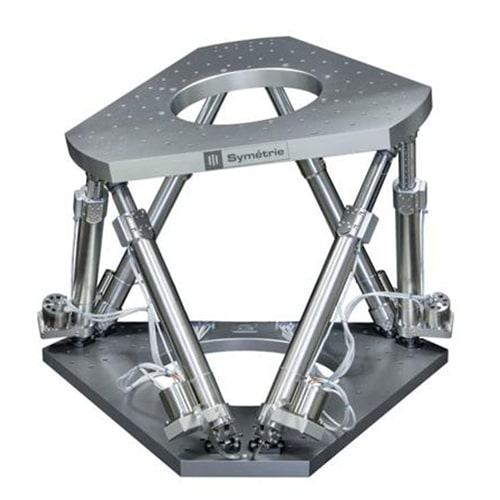Before purchasing a positioning hexapod, it is important to consider several key criteria, including size, load capacity, travel range, absolute encoders, resolution, repeatability, environmental conditions, controller, and software. Considering these criteria before purchasing a positioning hexapod can help you make the right choice for your lab or manufacturing facility.
A hexapod, also called a Stewart platform, is a mechatronic system with a parallel structure allowing the positioning and movement of objects in a 3D space using six degrees of freedom. Positioning hexapods are powerful and versatile tools used for precision with optical instruments in various scientific and industrial settings. They offer excellent performance, accuracy, and flexibility for precise positioning tasks.
Here are the main key criteria to consider when purchasing a positioning hexapod:
Load Capacity
Your choice of hexapod depends first on your payload. The load capacity of a hexapod can be as small as a few kilograms and as large as several tens of tons. An important parameter is the holding force of the hexapod, which means the payload it can handle even when powered off. A hexapod with an irreversible design will not move even if power is turned off.
Some hexapods can work in any orientation (vertical, horizontal, or upside-down), but the orientation may have an impact on the load capacity.
The position of the center of gravity of the payload may have an impact on the load capacity of the hexapod. Specifications listed on brochures are usually based on a payload with a center of gravity located in the center of the hexapod mobile platform.
Size and Travel Range
Positioning hexapods come in several sizes. The travel range of the hexapod is the range of linear and angular motions it can achieve in each direction. It is useful to know that travel ranges specified in brochures are usually single-axis motions, with all other axes at mid-range and for a rotation center in the middle of the mobile platform.
To test possible combined movements, simulation software such as HexaSym can be used to easily check whether your needs can be met by a particular hexapod model. Larger and higher-positioning hexapods have more travel ranges but will require more space.
Resolution
The resolution of the hexapod refers to the minimum incremental movement (linear or angular) the hexapod can perform in a consistent and detectable manner. Resolution is usually measured with high-precision metrology sensors.
Repeatability
The repeatability of a hexapod is the deviation from the average of actual positions reached when the system is commanded to go to the same desired position multiple times.
Absolute Encoders
The position feedback sensor retains position data after a power failure. Unlike an incremental encoder, there is no need for homing (moving the hexapod to its origin) to provide a value for its position. Thanks to absolute encoders, the hexapod can be used again after powering off without performing a homing motion first. An absolute encoder can be linear or rotary.
Control and Ease of Use
Ease of use is important when considering any industrial or scientific tool. It is important to choose a positioning hexapod that users who may not have extensive experience with the tool can operate quickly and safely. Users control the hexapod thanks to its GUI software and controller.
The Graphical User Interface (GUI) is an intuitive interface that allows the user to entirely control the hexapod. An easy-to-use GUI should allow easy connection to the hexapod, help the user perform relative or absolute motions, change the pivot point of the hexapod, perform homing, and provide hexapod status in real-time.
The Application Programming Interface (API) is a command line interface that allows communicating with the hexapod controller without using the GUI. This API can be compatible with, for example, Labview, Matlab, Python, C++, TANGO, or EPICS.
Environment
The environment in which the hexapod will be operated is also crucial. Some hexapods can operate on a wide temperature range (0 to 75 degrees Celsius, for example) or be stored at an even lower temperature of -20 degrees Celsius. In some cases, they could also be required to go into a low-pressure environment, a clean room (ISO 5 for example), or a vacuum chamber.
Cost
Determine how much you are willing to spend on the tool, and then look at models that fit your budget. Be sure to consider all other criteria as well, such as size, configuration, repeatability, accuracy, and ease of use. Find a balance of the features that best suit your application and budget. By considering these key criteria when selecting a positioning hexapod, you can ensure you get the best tool for your application at a reasonable price.
Tip
A software simulation tool like HexaSym can greatly help in choosing the best hexapod. Using HexaSym, it is possible to check the hexapod’s possible cumulative travel ranges and load capacities with respect to your configuration (hexapod orientation, pivot point, Payload, CoG location, etc.) It helps you select the most suitable product for your application and test a variety of possible configurations with it.

